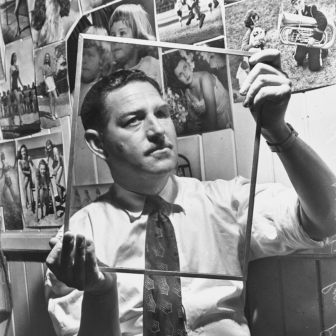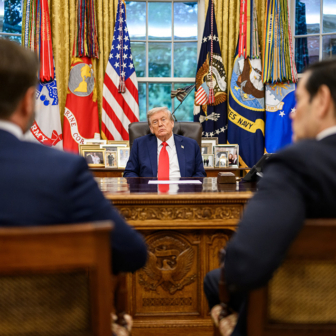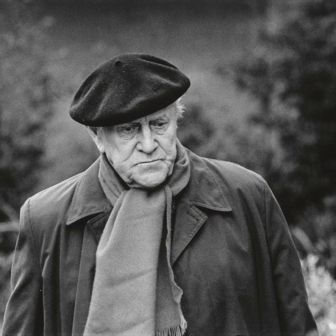Years ago, at the beginning of a sojourn in South Africa, I heard an elderly woman use the word “picannin” to describe an African child. Picannin, I thought, surely that’s Aboriginal, and with a “y” on the end. So I went to the Shorter Oxford Dictionary. Little black one, it said, derived from two Spanish or Portuguese words and coined in the Caribbean; now used only in Australia and South Africa. So words are maverick. They can stay wedged in a place or jump oceans — or even both.
The first of three recent books about words is Gobsmacked! The British Invasion of American English. It deals with quite the reverse of what we think of as the normal flow, for even before the end of the eighteenth century purists in England were using the term “Americanism” dismissively. Yet the writer Ben Yagoda, after living in England for some time, was struck on returning home by how many words and expressions he’d first encountered in Britain were now turning up in the States.
There had always been some; the term “Briticism” had been coined in 1868. But it is Yagoda’s contention that the number of NOOBs — not one-off Britishisms — has increased dramatically since the 1990s. Developments in technology and in the media, he points out, have accelerated linguistic cross-pollination among the varieties of English. (True: and dramatically illustrated by how the American “train station” dislodged the traditional English/Australian “railway station” — in place for over 150 years — at almost the same time.)
But it was not entirely a matter of technology. Yagoda points to the way a number of leading intellectuals, such as Christopher Hitchens, became transatlantic. And there was also the aura of Cool Britannia, extending to the Spice Girls, adding trendiness to the existing pull of prestige. If they wanted to sound posh (one of the words adopted) Americans had always used a Britishism. So “bespoke” — in England traditionally restricted to tailored clothing — has become much more widely used in America as a grand way of saying custom-built.
This is not to say that Britishisms are largely matters of trend or style. Many, writes Lagoda, have caught on because they offer value: “describing a thing for which there’s no precise American equivalent and in the process giving the American language a brisk, thanks-I-needed-that slap in the face.” Indeed a few, like “dicey,” are now more commonly used in America.
For years Yagoda has run a blog on NOOBs, and here he provides graphs showing comparative usage in America and Britain over the years, also providing a dot panel classifying words from Outliers (rare usage) through Adoption and Fully Arrived to Outpaced (“dicey” is one of these). His learning is carried lightly, and at times the book reads breezily.
One of the surprises of Gobsmacked is how frequently Australia appears in its pages. Given the tangle of influences operating in the old Commonwealth (with Barry Humphries as a prime pollinator) and given Yagoda’s immigrant perspective on words, this shouldn’t be unexpected. But there are other surprises. He tells us that the now almost obsolete swearword “bloody” was used more extensively in Australia than anywhere else. “Lost the plot” is convincingly shown to be of Australian origin. And the ubiquitous “No worries” — propagated by Crocodile Dundee, where it is used half a dozen times — has even provoked backlash banning on a US campus. “Good on you” (originally Norfolk dialect) took root here, as we all know, and is now heard across the world. Or mis-heard. When Liesel Jones used the expression commending a former swimmer’s appearance in Playboy (“Good on her!”) the Los Angeles Times heard it as “Good honor.”
We are still exploring our own language. It was developing with sufficient distinctiveness to prompt Professor E.E. Morris to publish in 1898 his dictionary Austral English, duly supplemented half a century later by journalist Sidney J. Baker’s racier The Australian Language. Linguistic studies followed in their wake, and in 1981 the Macquarie Dictionary appeared. Seven years later — for the bicentenary — came the first edition of the Australian National Dictionary, under the auspices of the ANU and Oxford University Press. A third (online) edition is now being prepared; entries will have almost doubled, to some 1800.
Amanda Laugesen, the chief editor, has already written a number of books on Australian language, but Australia in 100 Words more ambitiously offers a portrait of Australia by contextualising the chosen words. It has not been easy. As Laugesen explains, male archetypes abound, while far fewer words point to Australian women. Language has often reflected the power dynamic of white men. (Indeed, the gendered differential could not be sharper than when comparing the moneyed “bagman” with the homeless “bag lady.”) So “wherever possible,” Laugesen writes, “I have tried to find ways of putting other stories alongside these.”
The first entry is “deep time” — the complete opposite to the confident computation of Bishop Ussher, who, using Biblical sources, pronounced the world as having been created in 4004 BC. While the concept of deep time has been around since the eighteenth century (not long after Ussher), the term seems to date only from 1981. But how important it is, Laugesen writes, allowing us “to see ourselves as part of a much longer story of the universe.” Given the relatively short period of European settlement in Australia, it extends the narrative. “So perhaps it can help us to think differently about this country’s present and future.”
First Nations people, and words, figure prominently. Early on there’s a discussion of “Dreamtime” and “Songlines,” under the heading Tjukurpa. (The book is impeccably politically correct — but then it’s the nature of dictionaries to be prescriptive.) The point is nicely made that the Dreaming, being all of past, present and future, is a kind of “everywhen.” “Country” is there, juxtaposed with “New Holland,” where we learn that the name “Australia” did not originate with Matthew Flinders, but occurs on a number of early maps including one by Mercator. Among the inserts is a useful box on contact languages.
Contact also means “frontier wars,” and on them there is a well-turned essay. While acknowledging that the frontier was essentially a “zone of interaction,” Laugesen points to the massacres (defined as the killing of six or more), and to terms such as “dispersal” or “snipe shooting,” which indicated systematic eradication of blacks by “roving parties.” No wonder Aboriginal people refer to the “killing times.” There was also resistance — something which, until the 1970s, had been completely obscured, so much so that there was a common assumption that since they had not put up much of a fight (unlike the Māori) Aboriginal people’s possession of this land need not be taken seriously. The frontier wars, writes Laugesen, “are finally receiving their proper recognition as a foundational part of Australia’s post-1788 history.” Later entries extend to Invasion Day, Mabo, the radical Blak and the shouted-down Voice.
Laugesen makes a number of valuable general points about Australian English. That sometimes British dialect words — such as fossick — were used more widely here, and that their meaning could shift. Or that rhyming slang (“septic tank” for Yank), once strong in Australia, did not leap across the Atlantic to America. Again, that the diminutive ending -y or -ie was rarely attached to nouns until the twentieth century.
The book takes the form of using a keyword to explore a nexus. Thus it is less lexicographical than historical explorative. Rather than being alphabetical, the entries are loosely chronological, located according to when the keyword first appeared or when it was most influential. Some open up a whole new territory: “wallaby track,” for example, leads into a discussion of itinerant workers in Australia, a steady stream through most of our history. (It’s a pity Augesen misses the scepticism behind the term “sundowner” — applied to swaggies who would turn up at the end of the day seeking a bit of food and accommodation, when it was too late to do any work.) Some of these short essays, such as that on the thylacine, could sit as well in an encyclopaedia as in a book on language.
A more typical essay is that on the bush. The book points out that the term — so Australian — first appeared in South African English, adapting a Dutch word. It notes that it was a flattening concept, equivalent to wilderness, blind to any Indigenous presence or land use. It became the core of an emerging Australian identity (despite heavy urbanisation) since it was there that this country was most different from England. Not surprisingly, Laugesen deems it “the most productive word in the country’s lexicon.”
The entry for the word “hoon” is an interesting one, enabling Laugesen to explore Australia’s car culture. She notes that the word was originally applied to a pimp, without adding that flash dressing — showing off — became transferred to flash behaviour, and hence associated with young men tearing around — hooning around — in fast cars. But she misses how “hoon” bridged the gap as “ocker” faded away in the 1980s and “bogan” had not yet emerged. This is a sore point with me: after having written a review of Murray Bail’s Holden’s Performance (1987) I was reprimanded by a lexicographer in a letter to the editor for having distorted the word from its “correct” meaning. The perils of relying on recorded sources… particularly if in Canberra, when meanwhile and elsewhere the language is moving on. Since then, “hoon” has done that rare thing for a word, taken a U-turn. Since “bogan” is now widely used, it has regressed to the world of wheelies and burnouts.
The idea behind Australia in 100 Words is a smart one, and some of the essays are models of their kind. But words are not determinants (except in the hands of bureaucrats); rather, they are markers, recognitions. Their use is indicative of trends: a kind of snap poll. But they will only take you so far. Thorough-going history will always be needed; otherwise it’s like preferring musical notation to performance.
Sometimes Laugesen could have pressed a little further. The word “Pom,” once ubiquitous, scarcely gets a mention — nor the fact that it is rapidly becoming obsolete. (A young Englishman told me that he had to give up introducing himself as one, as people didn’t seem to know what it meant.) The obscene side of Australian speech is underrepresented — no “perve,” but then the word may well be a casualty of changed sexual mores. It should be said though that Laugesen has also written a whole book on Australian rude words.
Laugesen is optimistic about Australian English continuing to go on its own sweet way. She may be right, so far as vocabulary and expression are concerned, but less so with pronunciation. I’m worried (“o” as in money) about worried (“o” as in drop). In the last eighteen months the American pronunciation has been heard with increasing frequency. But as for our own idiom, there’s still hope. In a Melbourne tram recently, I saw a man (Indian) step on a (Chinese) man’s foot. “Sorry, mate!,” he said. “No worries,” came the reply.
The real narrative in Australia must be what happened to First Nations languages, and how they are boomeranging back. While it is beginning to be understood that there were many Aboriginal languages (some 440) at the time of first contact, it is not generally realised how very different from each other they are. Languages spoken in adjacent areas can be as different as English is from Arabic or Chinese — an indication of how very long Aboriginal people have inhabited this continent. Whereas a Spaniard and an Italian can understand each other if they speak slowly, this did not work when people on Sydney Harbour’s northern shore met those from the other side.
Bina: First Nations Languages, Old and New is the work of three linguists, two of them Indigenous. The word is widely used across Australia, and pertains to the ear, to listen, and to know. (Aboriginal people sensibly say “I hear” instead of the English “I see.”) Much of the book, of necessity, is technical. But the narrative line is strongly and clearly set forth, telling the story from the days of first contact to the present.
The brutal impact of white settlement is related concisely — and ratified by the way an early recorder of Indigenous language noted that Aboriginal people frequently called whites by the same word they gave to a musket. (Even Governor Phillip, generally benign towards the Indigenous, called for the heads of any six Gamaraygal people following the spearing of convicts.) Frontier brutality, together with the sustained resistance of Aboriginal people, are now taken as givens.
But the impact of the missions was in some ways more insidious — particularly as the word came to be applied to any supervised Indigenous settlement. Fragments of first nations, having lost their lands, were thrown together there, and every effort was made to eradicate traditional culture. Family units were often broken up, language banned, people punished for using it. It was the beginning of the stolen generations, and of “language erasure.” The result is that only forty Aboriginal languages have been spoken continuously since 1788, and only twelve are still being learnt by children.
For people who were usually multilingual from necessity, the linguistic response has been inventive. Among other things, Bina shows how first there arose New South Wales Pidgin, which spread northwards and even fed into Melanesian Pidgin. Over the course of time pidgin expanded from being the lingo of functional exchange to eventually becoming an English-based first language, acquiring a grammar as well as an extended vocabulary. This is when the term creole language becomes applied, and Australia has two of them: Kriol, spoken across the north, and Yumplatok, spoken among Torres Strait Islanders. Mixed languages have also emerged, combining Kriol and Aboriginal English with traditional languages in interesting ways.
Given this linguistic plasticity, the Whitlam government in 1973 decided to establish five pilot bilingual education schemes in the Northern Territory (then ruled from Canberra). It was the era of the land rights and outstations movements, and of a push towards greater Indigenous self-determination. Provision for education in first (Indigenous) languages was included, plus an extensive program in bilingual education that proceeded over the next decade. As well as learning English — sensibly not introduced till third grade — the kids would have their own languages and knowledge systems reinforced. It proved remarkably effective, as evidenced in most NAPLAN results.
But in 2008, in the context of John Howard’s Intervention, the Territory government (Darwin ruled now) decided to introduce the “Four Hours of English policy.” These usually began the day; the Indigenous component tended to wither away. English took primacy again. But this leads to comprehension problems, and runs counter to the research, which shows that children perform better when they are instructed, and develop literacy skills, in their community language first.
Included in the National Agreement on Closing the Gap (2020) was a commitment to “a sustained increase in number and strength of Aboriginal and Torres Strait Islander languages spoken.” Meanwhile, following the UN Declaration on the Rights of Indigenous Peoples, to which Australia is a signatory, UNESCO has announced an International Decade of Indigenous Languages (2022–32).
We are going to hear much more about these issues — not least because Aboriginal people continue to chalk up victories in surprising places. Not only has Macbeth been translated into Noongar, and performed, but so too were Shakespeare’s sonnets — on the stage of the Globe Theatre in London. Then, last year, Indigenous artist Archie Moore won a Golden Lion for his installation at the Venice Biennale. Meanwhile there’s a growing cohort of Indigenous graduates spreading through the country. In 1966, Australian universities produced their first Aboriginal graduates, Charles Perkins and Margaret Valadian; now there are seventy from Deakin alone. And so the wave sweeps on — swerving to include the pop sensation The Kid Laroi, with his eighty-five million likes on Tik-Tok.
Finally, a report on picanniny’s progress. The word has largely sloughed off its pejorative connotations and found a place in Kriol. It has even received a royal assent. When touring Papua New Guinea in 2012, the then Prince Charles endearingly described himself as “numberwan pikinini bilong Misis Kwin” (Elizabeth II). •
Gobsmacked! The British Invasion of American English
By Ben Yagoda | Princeton University Press | $39.99 | 274 pages
Australia in 100 Words
By Amanda Laugesen | NewSouth | $32.99 | 274 pages
Bina: First Nations Languages, Old and New
By Gari Tudor-Smith, Paul Williams and Felicity Meakins | La Trobe University Press/Black Inc. | $37.99 | 379 pages




